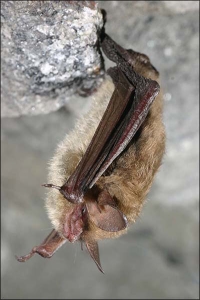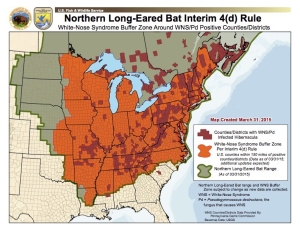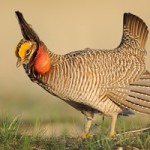The northern long-eared bat is a medium-sized bat about 3 to 3.7 inches in length with a wingspan of 9 to 10 inches and, as its name suggests, long ears. The northern long-eared bat is found across much of the eastern and north central United States and parts of Canada. The bat is federally listed as a threatened species under the Endangered Species Act (ESA).
Why is the northern long-eared bat in trouble?
According to the U.S. Fish and Wildlife Service, the primary threat to the existence of the northern long-eared bat is a pandemic fungal disease called white-nose syndrome, a disease known to infect the muzzle, ears, and wings of hibernating bats. In the Northeast, the species has declined by up to 99 percent from pre-white-nose syndrome levels at many hibernation sites. Infected bats often display abnormal behaviors in their habitats, such as movement toward the mouth of caves and daytime flights during winter. White-nose syndrome has and continues to spread within the range of the northern long-eared bat. No other factor or human activity imposes an existential threat to the species.
Where is the northern long-eared bat located?
The northern long-eared bat is found across much of the eastern and north central United States and all Canadian provinces from the Atlantic coast west to the southern Northwest Territories and eastern British Columbia. The species’ range includes the following 37 states and the District of Columbia: Alabama, Arkansas, Connecticut, Delaware, Georgia, Illinois, Indiana, Iowa, Kansas, Kentucky, Louisiana, Maine, Maryland, Massachusetts, Michigan, Minnesota, Mississippi, Missouri, Montana, Nebraska, New Hampshire, New Jersey, New York, North Carolina, North Dakota, Ohio, Oklahoma, Pennsylvania, Rhode Island, South Carolina, South Dakota, Tennessee, Vermont, Virginia, West Virginia, Wisconsin, and Wyoming.
Click here for a list of U.S. counties in the northern long-eared bat’s range.
What is being done to help the northern long-eared bat?
- 2006: Symptoms of White-nose syndrome first observed in New York.
- October 2013: Fish and Wildlife Service proposes an endangered listing under the Endangered Species Act.
- January 2014: Stakeholders recommend possible 4(d) rule option.
- January 16, 2015: Fish and Wildlife Service proposes 4(d) rule in case threatened listing found for the bat.
- April 2, 2015: Fish and Wildlife Service list the northern long-eared bat as threatened under the ESA, while also publishing an Interim 4(d) rule.
- May 4, 2015: Interim 4(d) rule takes effect.
- July 1, 2015: Comment period on the interim 4(d) rule closes.
- January 14, 2016: The U.S. Fish and Wildlife Service published its Final 4(d) Rule on the northern long-eared bat in the Federal Register.
What is a 4(d) rule?
A 4(d) rule is one of many tools provided by the Endangered Species Act to allow for flexibility in the Act’s implementation and to customize regulations to those that make the most sense for protecting and managing at-risk species. The goal of a 4(d) rule is to ensure private landowners and citizens are not impacted by regulations that do not further the conservation of the species and, when conducting certain activities, are exempted from “take” prohibitions (defined in the ESA as to harass, harm, pursue, hunt, shoot, wound, kill, etc.). This rule may be applied only to species listed as threatened and directs the Fish and Wildlife Service to issue regulations deemed “necessary and advisable to provide for the conservation of threatened species.”
On January 15, 2015, Fish and Wildlife Service published a proposed 4(d) rule for the northern long-eared bat and opened a public comment period on the proposal. In April, federal regulators published an interim 4(d) rule in conjunction with the final rule to list the northern long-eared bat as threatened. There was also a 90-day public comment period open until July 1, 2015 on the interim rule for the Fish and Wildlife Service to gather additional information and finalize the rule, a process IPAA was actively involved in.
On January 14, 2016, the U.S. Fish and Wildlife Service published its Final 4(d) Rule on the northern long-eared bat in the Federal Register. The Final Rule exempts oil and gas activities from incidental take prohibitions in the same way that forest management activities were exempted.
What does this mean for the northern long-eared bat?
For areas of the country not affected by white-nose syndrome (i.e., areas outside the white-nose syndrome buffer zone), the 4(d) rule exempts incidental take from various activities.
According to Fish and Wildlife, the final 4(d) rule:
- “Prohibits purposeful take of northern long-eared bats throughout the species’ range, except in instances of removal of northern long-eared bats from human structures, defense of human life (including public health monitoring), removal of hazardous trees for protection of human life and property, and authorized capture and handling of northern long-eared bats by individuals permitted to conduct these same activities for other bats until May 3, 2016.”
- “Incidental take resulting from otherwise lawful activities will not be prohibited in areas not yet affected by white-nose syndrome.”
- “Take of northern long-eared bats in their hibernacula is prohibited in areas affected by WNS, unless permitted under section 10(a)(1)(A) of the Act.”
- “Incidental take resulting from tree removal is prohibited if it: (1) Occurs within a 0.25 mile (0.4 kilometer) radius of known northern long-eared bat hibernacula; or (2) cuts or destroys known occupied maternity roost trees, or any other trees within a 150-foot (45-meter) radius from the known maternity tree during the pup season (June 1 through July 31).”
- “Incidental take of northern long-eared bats as a result of the removal of hazardous trees for the protection of human life and property is also not prohibited.”
In regard to the oil and natural gas industry, Fish and Wildlife states “take of northern long-eared bats attributable to habitat conversion and habitat loss is not prohibited under this final 4(d) rule, provided that developers and project proponents follow conservation measures described herein when activities occur within the WNS zone.”
What has IPAA done in regard to the listing of the bat?
IPAA joined with numerous other industry groups in January 2014, August 2014, December 2014, and March 2015 urging the Fish and Wildlife Service not to list the northern long-eared bat as endangered. In their March 2015 comments, IPAA and API specifically requested that all oil and gas development activities be exempted from the prohibition against incidental take of the bat through the proposed special rule. In July 2015, the associations again urged the Fish and Wildlife Service to amend the Interim 4(d) Rule for the northern long-eared bat to reflect the fact that oil and gas development activities do not pose a significant threat to the existence of the bat. IPAA has also been outspoken in the media on the impacts of a listing. As President Barry Russell pointed out in the Pittsburgh Post-Gazette, the real threat to the northern long-eared bat is a pandemic fungal disease known as white-nose syndrome – not human activity – and an ESA listing offers no tangible benefits to the bat’s population or the prevention of this deadly disease.
Check out more news on the northern long-eared bat on ESA Watch HERE.







